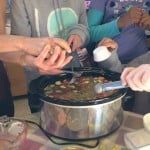Bring the Home into the Classroom – Literally!
 What is one artifact or symbol that can literally make students feel “at home” in the classroom? An artifact that can ease stress, encourage conversations, build relationships, have no limitations of age or ability and be completely diverse in nature?
What is one artifact or symbol that can literally make students feel “at home” in the classroom? An artifact that can ease stress, encourage conversations, build relationships, have no limitations of age or ability and be completely diverse in nature?
A KITCHEN TABLE!
In our home, The Kitchen Table is not just where we gather for meals but where we gather to talk about our day. It is the first stop when getting up in the morning, returning from a walk or coming home from work. Where we throw down our keys, where we pile up our books and add to the week’s worth of newspapers. It is where we charge our phones and open our computers and play our music. It is our card table, our game table, an art centre and a sewing station. It is where the mail gets read and sorted and where the bills get paid. The table is a space for food preparation, for sorting groceries and for sharing surprise snacks. Sometimes, the table is our refuge after a long day- a safe place to sit and gather, where we talk and plan and discuss and cry. Our best arguments happen around the table and our best apologies follow. Sometimes, it is a place to sit together in silence reading or writing.
Whatever it is and whatever time of day – it is always a safe place to be ourselves, to take risks, to be honest, to be vulnerable and to love one another.
And so, in effort to create an environment of trust, we brought the Kitchen table (literally) into the classroom and built a kitchen around it. We created a situation – a small space, a “feeling” where students could be vulnerable, tell stories, laugh, cry and be themselves. The following 2 minute video gives an excellent description of why we start and end our day at the Kitchen Table.
Our Kitchen Philosophy
We strive to connect MIND, BODY & SPIRIT by connecting what we study with HOME. FOOD is a NEED that connects Families and develops COMMUNITIES. The development of a COMMUNITY of learners allows students to take risks, be mentors, have leadership opportunities and push the boundaries of their learning.
We address the role of the family and the community in our daily living.
We value our connection to the land by creating and sharing healthy snacks and meals.
We offer experiential learning opportunities.
We discuss respect for the group process and the significance of balance in all aspects of our lives.
When we are HOME we feel free to be ourselves !
We all can LEARN & GROW together!







